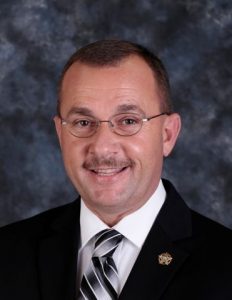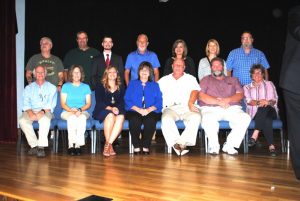News
Sheriff to Begin Citizen Academies
October 19, 2018
By: Dwayne Page
DeKalb County residents will soon have a chance to get a closer look at the operation of the Sheriff’s Department and Jail.
Sheriff Patrick Ray is establishing a Citizens Academy. The idea is to offer a series of classes once or twice a year on the day to day operations of the sheriff’s department and jail. The course will also cover simunition firearms training, investigations, traffic stops, and other subjects. Participants will even get to ride along with a deputy for a night.
“The purpose of the Citizens Academy is to foster better communications between citizens and the Sheriff’s Department through education and cooperation,” said Sheriff Patrick Ray.
The classes will meet once a week for three hours each night over an eight week period. Class size is limited.
The first session will be just for the county commissioners and the county mayor starting in February. After that Sheriff Ray will open the academy to the public, possibly by next fall.
All participants who sign up for the academy must be 21 years of age or older, pass a criminal background check, and sign a release of liability form.
“Because of the firearms training, no participant can have a felony criminal conviction, a domestic violence conviction, pending criminal charges, be under an order of protection, or have been involuntarily committed to a mental institution,” said Sheriff Ray.
The sheriff said he is looking forward to starting this new public service.
“This is a great way for the public to have a better understanding of the department and a better informed citizen is more likely to share their experience with the community as the opportunity arises. Everyone benefits from enhancing citizens knowledge of the role and function of the Sheriff’s Department,” said Sheriff Ray.
Commission to Consider Giving Its Blessing For New Pre-K to 2 Elementary School Plan
October 19, 2018
By: Dwayne Page
The DeKalb County Commission is expected to decide Monday night whether to give its blessing on the Board of Education’s plan to build a new Pre-K to 2nd grade school adjacent to Northside Elementary to replace Smithville Elementary School.
While no plans are yet in place to fund the project, the school board wants to make sure the county commission is in agreement with this specific (Pre-K to 2nd grade) proposal, before a contract is entered with its architect Upland Design Group to develop plans for the construction phase. The proposed new school, 98,000 square feet, would accommodate 800 students. The estimated project is $19,464,500 but that figure does not include costs of site preparation or the purchase of additional land if needed. The Tennessee Department of Transportation also requires a traffic study be done anytime a new school is built near a state highway. Findings of that study as it relates to increased traffic flow and congestion at this location will also be a factor in how the architect draws the plan. Once those issues are resolved and the school board arrives at better cost estimates, the budget committee has signaled its willingness to start working on a financial plan to fund the project, subject to final approval of the county commission.
In other business, the county commission Monday night will decide whether to grant County Clerk James L (Jimmy) Poss’ request to make a part time position in his office full time. To fund the request, the commission is being asked to adopt a $15,896 budget amendment for the pay period October 29, 2018 to June 30, 2019. The funds would be taken from the county’s fund balance (cash reserves) to pay for it. That would give County Clerk Poss a total of four full time employees in his office. The county budget committee Tuesday night voted 4-1 to recommend to the county commission that the budget amendment be approved.
County Clerk Poss said the workload in his office has increased over the last four years with more services added to better accommodate the public and the county has benefitted from the increased revenues those services have generated.
In other business, the county commission Monday night will consider making appointments to the 911 Emergency Communications District Board, as recommended by that board; consider approval of budget amendments, quarterly reports, and notaries.
Monday night’s county commission meeting will be held on the third floor of the courthouse starting at 6:30 p.m.
Free Classes Available to Those Seeking High School Equivalency Diploma
October 18, 2018
By: Dwayne Page
A high school diploma remains the primary ticket to many entry-level jobs. It is also generally the prerequisite for advancement in employment, occupational training and postsecondary education. The high school equivalency diploma provides adults with the opportunity to grow, whether it is through further education, enhanced employment, or stature within the community.
Free High School Equivalency Classes are held in DeKalb County on Mondays from 4:30 p.m. until 7:30 p.m. Registration is Mondays from 4-7 p.m. and Tuesdays from 9 a.m. until 12 noon. Financial vouchers are available to assist with testing fees.
Don’t see a time that works with your schedule? Ask about special appointments.
Classes meet at the DeKalb County Complex-Room 119
Call 1-855-516-0160 for more information or to schedule an appointment.
In order to enroll, you must meet the following eligibility requirements:
•Must be 18 years of age.
•Not enrolled or required to be enrolled in secondary school
•Do not have a secondary school diploma or its recognized equivalent
To begin, individuals will take the CASAS® (Comprehensive Adult Student Assessment Systems) assessment to evaluate their reading, math, and language arts abilities. This will provide both the instructor and the student with an idea of where to best start the instructional process and insure that no valuable time is wasted between enrollment and successful completion of the program.
After completing some classroom instruction hours, students take another short CASAS® test to demonstrate academic gains and to allow the instructor and student to then work together in order to refine the learning process in order to prepare the student for the official practice test, or OPT. The goal is to assist the student to reach his/her goal in the shortest amount of time possible.
The Official Practice Test (OPT) has the same look and feel as the real High School Equivalency Test (HiSET®). The OPT allows the student to obtain firsthand experience answering questions written and developed by the HiSET® test creators. The results of the OPT indicate whether or not an individual is prepared for the HiSET®.
Finally, Governor Haslam and TN General Assembly have allocated funds to cover the cost of the official HiSET® exam. Individuals throughout the State of Tennessee can now enroll in classes and take the HiSET® in order to receive a high school equivalency diploma at no cost.
« First ‹ Previous 1 2081 2171 2179 2180 21812182 2183 2191 2281 2504 Next › Last »










